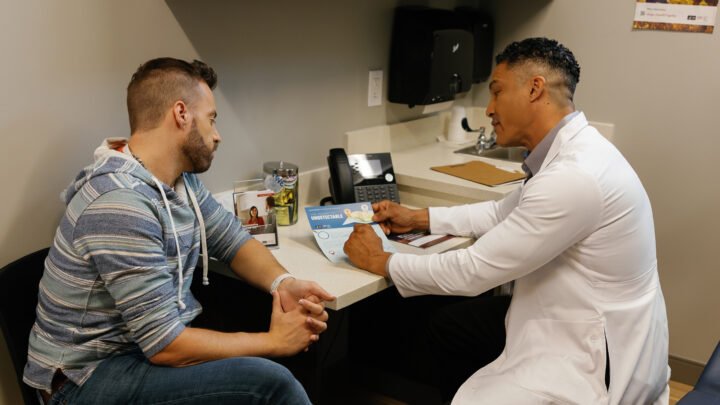
The internet has changed how patients search for physicians. From researching symptoms to choosing specialists, potential patients rely on search engines to find the healthcare answers they need. For medical practices and physicians, this shift opens a window of opportunity—but only if your website is optimized for search engines. That’s where SEO (Search Engine Optimization) for healthcare comes in.
SEO has become a necessity for modern medical practices seeking to attract more patients, establish credibility, and outrank competitors. It’s no wonder that 67% of physicians surveyed on Sermo say their practice currently leverages some form of SEO content marketing. One general practitioner shared on Sermo, “I’ve found content marketing to be a great way to connect with patients and build trust. When it’s done right, it really helps with engagement and growing your practice.” Keep reading to discover how physicians can leverage this powerful marketing strategy to grow their career and impact.
What is SEO for healthcare services?
SEO simplified
SEO refers to the strategies and techniques used to improve a website’s visibility in search engine results. When done effectively, it helps websites rank higher on platforms like Google, Bing, and Yahoo for terms users search for, increasing organic traffic to that site.
Healthcare-specific SEO
Healthcare SEO tailors these strategies specifically for medical websites. It involves optimizing content, site structure, and local listings to ensure your practice appears when people search for terms like “dermatologist near me”. Successful healthcare SEO focuses on answering patient questions, providing high-quality health information, and complying with guidelines specific to the medical industry.
For example, practices can create pages centered on patient interests, such as treatment details or wellness tips, to enhance visibility, trust, and relevance. Many technical and non-technical aspects influence your SEO ranking, which this article covers below, but providing credible, evidence-based resources that offer educational value to patients form the foundation of successful healthcare-specific SEO.
Why is SEO important for medical practices?
Google alone receives more than 1 billion health-related queries daily, covering everything from basic condition research to self-diagnosis and provider locations. SEO offers numerous benefits for medical providers, impacting how effectively you attract and retain patients. In a recent poll, physicians shared that their primary practice marketing goals are educating patients about medical conditions and treatments (19%), increasing patient engagement and trust (16%), and generating new patient inquiries or appointments (13%).
1. Improved online discovery
When patients search for specific treatments or services, effective SEO ensures that your medical practice appears as a solution. Optimizing for common searches like “pediatrician Chicago” or “knee surgery New York” increases the likelihood that your clinic will be found by patients actively seeking care.
“For most physicians, patients either type in the doctor’s name + city, or a keyword phrase associated with their problem, like ‘addiction clinic minnesota’. The rating sites won’t even matter if your name isn’t appearing in the results pages… Just make sure to dominate the results with stuff you own from multiple online media channels (Facebook, Twitter, YouTube). I would not hesitate to be very organized about getting referrals (put the tackiness issue out of your mind) – you are a business like any other. Still, you just have to tiptoe more carefully around privacy issues. If patients are happy, that’s a natural extension of a great doc-patient relationship, and referrals flow out,” shared an orthopedic surgeon on Sermo.
2. Cost-effective alternative to paid advertising
Unlike PPC (Pay-Per-Click) campaigns that require ongoing investment, SEO builds long-term organic visibility. Once your website ranks well, with minor updates as search engine algorithms change, you can enjoy consistent traffic without paying for every visitor. For healthcare providers, this means more patient inquiries at a lower cost per acquisition.
As one internal medicine doctor and Sermo member stated “I have tried lecturing in the community, print ads, writing medical articles for local papers, radio ads, open houses, promotions with give away contests, advertising on YELP, Facebook, television ads, signs in other local business I found my best source of attracting new patients was personal referral and a great SEO person.”
3. Targeting the right patients
Effective SEO uses targeted keywords to reach the most relevant audiences, such as those searching for specific services. Targeting keywords that your patients are searching for online, relevant to your specialty and services, connects you with motivated, high-intent patients actively searching for your expertise.
4. Builds credibility and trust
A higher rank on search engines isn’t just about visibility. Appearing on the first page signals authority and trustworthiness to prospective patients. For physicians, establishing online credibility can be just as essential as personal bedside manner.
5. Offers measurable results
Unlike traditional forms of marketing, SEO provides data-backed insights to measure success. Tools like Google Analytics allow you to track everything—from how users find your site to which actions they take after visiting (e.g., calling your practice).
Common challenges of medical SEO
While rewarding, SEO for healthcare comes with unique challenges. “With properly applied SEO techniques, you can rise to the top for targeted keywords. It is, however, not ‘simple.’ It’s a rapidly changing, complex endeavor,” wrote a neurologist on Sermo.
According to a recent poll, the biggest challenges identified by physicians in creating content for their practice are:
- 31% struggle with time due to busy schedules
- 10% find it difficult to balance content creation with patient care
- 11% identified that creating easy-to-understand content can be challenging, and
- 10% struggle to find the right topics to attract and engage patients
Other challenges include ensuring content accuracy (6%), complying with regulations like HIPAA (8%) and managing technical aspects like website management (9%). Lastly, 4% face difficulties obtaining patient consent to share testimonials publicly.
Below are some additional challenges that medical content creators might face:
1. Highly competitive keywords
Short keywords are broad, general search terms. They typically include one or two words like “urgent care” or “family doctor” and are incredibly competitive, making it harder for smaller practices to rank. They don’t always indicate exactly what the patient is looking for.
Long-tail keywords, on the other hand, are more specific phrases, usually three or more words—for example, “pediatric dermatologist in New York” or “minimally invasive knee surgery recovery time.” While fewer people search these longer phrases, the ones who do are more likely to be serious about booking an appointment or getting a specific answer. Identifying niche long-tail keywords can help, especially when first starting out with SEO.
Think of it like this: short keywords cast a wide net, while long-tail keywords zero in on the exact patients who need your specific services.
2. Authoritativeness and YMYL guidelines
Ranking well requires meeting search engines’ standards, which are regularly changing. Google ranks based on Experience, Expertise, Authority, and Trustworthiness (E-E-A-T). Initially, establishing these can be difficult, as it is largely based on how many other credible sites link back to your site (known as backlinks). Missteps in these areas can lead to poor rankings regardless of how well your site is written or optimized.
YMYL refers to web pages with content that could significantly affect a person’s happiness, health, finances, or safety if inaccurate or misleading. Google uses the YMYL category to flag content requiring higher scrutiny due to the risks of misinformation, including financial advice, medical information, and legal guidance.
These pages must meet high E-E-A-T standards to rank well on search engines. Creating YMYL content that adheres to Google’s guidelines is essential for ensuring trust and credibility online.
3. Regulatory restrictions on healthcare information and advertising
Healthcare providers must balance SEO with strict regulations, such as HIPAA. This is why nearly 1 in 10 surveyed physicians said that creating content that follows medical guidelines was their biggest challenge in this type of marketing.
4. Local search constraints
Rankings are often tied to location, meaning practices outside large population hubs might struggle to attract online inquiries from broader audiences. In rural areas, the search volume of location-based keywords is generally much smaller.
5. Artificial intelligence ranking
As more people start to use AI tools like ChatGPT or Perplexity for their internet searches, traffic is being pulled away from traditional search engines like Google. Fortunately, there are ways to ensure your content is included in AI search outputs. Many SEO tools now offer ways to audit and monitor AI rankings, which often differ from traditional search engine ranking guidelines.
Core components of an effective healthcare SEO strategy
1. Keyword research
Identify keywords that your patients are searching for. Fundamental keywords to include in content are based around specialty-specific topics, diseases or conditions, locations, procedures, patient education, and FAQs. As mentioned, long-tail keywords like “back pain specialist in Miami” are more actionable and less competitive than vague ones like “orthopedic surgeon.”
2. High-quality content creation
Google and other search engines prioritize content that is authoritative, accurate, and helpful. Create blog posts, FAQs, and service pages that directly address patient concerns and follow E-E-A-T guidelines for healthcare content. Include author bios for credibility (e.g., [Dr. John Doe, 15+ years in cardiology]). Ensure content references reputable sources.
3. On-page optimization
Effective SEO for your website hinges on several crucial elements. On-page optimization includes descriptive alt tags for images, strategic use of heading tags for content hierarchy and readability, and mindful application of bold and italics for emphasis without overdoing it. Your footer can also boost SEO through strategic internal linking. For industries like healthcare, regularly updating and auditing content is paramount to maintain accuracy, relevance, and improve search engine performance.
4. Local SEO
Optimize your practice’s Google Business Profile with location-specific keywords. Encourage patients to leave positive reviews on healthcare-specific platforms like Healthgrades, Zocdoc, and Vitals. Make sure to include online references on your website, social media profiles, and articles, known as citations, to your healthcare organization’s name, address, and phone number (NAP).
Additionally, make sure that your practice is consistently listed across online directories. Popular healthcare content directories include MedlinePlus.gov, SAMHSA.gov, HealthGrades, RateMDs, VeinDirectory.org, NIH.gov (including MeSH), RealSelf, AMA Doctor Finder (and InnovationMatch.AMA-assn.org), CMS Physician Compare, and Castle Connolly Top Doctors.
5. Technical SEO
Technical SEO involves a number of strategies. Grouping related topics with internal links helps both users and search engines understand your site’s structure, improving crawlability, indexing, and ranking.
Site speed and mobile responsiveness are rewarded by Google. Anchor text in your links should be relevant and contextual, distinguishing between beneficial outbound links (to credible sources) and crucial internal links that enhance navigation and reinforce your keyword strategy. Ensure fast load speeds, mobile responsiveness, and secure HTTPS encryption to protect patient data. Finally, an XML sitemap aids search engine crawling.
6. Backlinks
Build authority by earning links from reputable healthcare directories or writing guest posts for trusted medical sites. The more credible backlinks your site earns, the higher your ranking rises.
7. Measuring and analyzing SEO results
SEO is an ongoing process. Use tools like Google Analytics, SEMRush, or Ahrefs to measure performance and refine your strategy.
For more actionable tips, see Sermo’s healthcare SEO guide.
Should you outsource SEO or keep it in-house?
When physicians were asked who manages content marketing for their medical practice, here’s how they responded:
- 24% handle it themselves or collaborate with others
- 29% rely on a dedicated marketing department at their workplace
- 9% delegate it to office staff who manage it in their spare time
- 5% hire a freelance marketer specifically for content creation
- 33% reported that no one is currently managing content marketing
When weighing the decision to outsource SEO or manage it internally, consider factors such as budget, expertise, and scalability. A Gynaecologist on Sermo shared, “I’ve tried to start creating my personal brand in the past 3 months but so far I’ve realised that is way harder than expected.”
While larger practices often hire agencies or build an in-house marketing team, smaller practices tend to rely on freelance marketers or handle it themselves. See our additional physician resources for more ways to grow your practice or attract new patient bookings through digital marketing.
Elevate your practice’s online presence today
Medical SEO is not a set-and-forget strategy; it’s an investment in your practice’s growth. As a family medicine physician discussed on Sermo, “I completely agree that content marketing is a game-changer for patient-centered practices. In my experience, even simple educational posts can build trust and bring in new patients. The tricky part is finding time to create consistent, compliant content while juggling clinical duties.”
By improving your website’s rank, engaging potential patients, and building online trust, your practice can remain competitive in an increasingly digital world.
At Sermo, our physician community offers practical expertise, resources, and insights to help you grow your career and impact. Join Sermo today to see how top physicians are leveraging this powerful marketing strategy.
People also ask (PAA):
In healthcare, SEO is used to improve a medical practice’s online visibility, credibility, and attract more patients by optimizing website content, structure, and local listings for search engines.
The cost of medical SEO varies widely based on factors like the scope of services, the agency’s expertise, and the competitiveness of your market, ranging from a few hundred to several thousand dollars per month.
To do SEO for a clinic, focus on local SEO by optimizing your Google Business Profile and other online directories, creating high-quality content addressing patient needs, and building strong backlinks to establish authority. Regularly monitor your performance with analytics tools to refine your strategy.
The four main types of SEO are On-Page SEO, Off-Page SEO, Technical SEO, and Local SEO. Each type focuses on different aspects of website optimization to improve search engine rankings and visibility.















